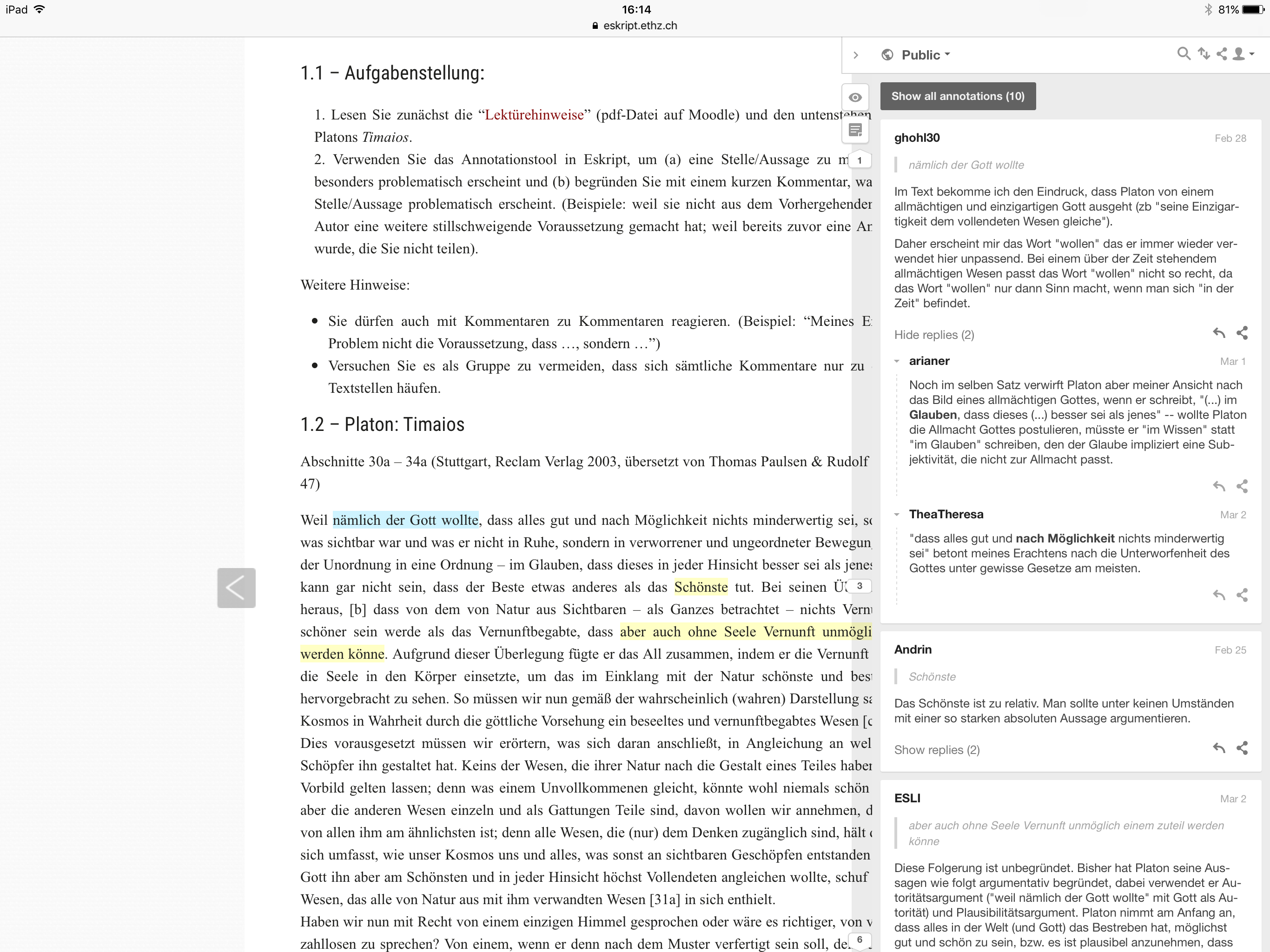Students read the assignments and using the hypothes.is annotation
- answer predefined questions (by lecturers/assistants/peers)
- ask questions about difficult passages
- paraphrase
- discuss interesting points
- attach complementary material
- prove points with links to other research
- reflect and form opinions
Detailed task (for lecturer and students)
Students read texts published on eSkript or on the Internet and use annotation to work on the information and process it.
To do:
- Choose text and design the assignment
- Open a hypothes.is-group for group-private annotation
- Inform students about assignment and how to become a member in the hypothes.is-group
Profit
The annotations (discussions, argumentations, explanations) happen in the context so that no (mostly difficult) referencing is needed. Links to other research and additional material can easily be added and a web of specific and relevant information can grow. The view in context is appealing (especially in contrast to a forum, which is the alternative for such tasks) and the dashboard gives a very good overview of the work done, with good filtering functionalities when tagging is used. (Annotations can be tagged by topics, assignments, groups, or any relevant keywords.)
Caveat!
You need to instruct students clearly on what the assignment is. It is also important that they use the hypothes.is group to annotate and that they do not annotate publicly unless the Copyright and Data Privacy Protection issues are crystal clear to them.
Case: Critical lecture Philosophical Texts
In spring 2017 students from 851-0147-01L Philosophical Reflections on Physics II were asked to read published texts on eskript.ethz.ch, find muddy points and comment on them in groups. This is the eSkript that was used: https://eskript.ethz.ch/philophys/.
The students’ instructions that were used can be found in the introductory chapter ‘Annotationstool‘.
PD Dr. Norman Sieroka gave us feedback after their planned use on one of Plato’s text:
Unsere Studierenden haben im Semesterfeedback sehr positiv auf die Verwendung von Eskript [und hypothes.is] reagiert/geantwortet — sowohl als “Disziplinierung” für sich selbst beim Lesen als auch (und vor allem) als Hilfsmittel, um eine Diskussion von Texten vorzubereiten und Themen zu spezifizieren. Und auch wir [die Dozierenden und Assistierenden] sind von der Qualität und Art der Kommentare positiv überrascht.
Translation (Eng): Our students have responded / reacted very positively to the use of eskript [and hypothes.is] in the semesterfeedback – both as a “discipline” for themselves in reading as well as (and above all) as an aid to prepare a discussion of texts and specify topics. And we [the lecturers and assistants] are also positively surprised by the quality and nature of the comments.
More about General Annotation Strategies
(http://www.teachthought.com/pedagogy/literacy/owl-eyes-12-ways-to-use-digital-text-annotation/)
Basic Text Annotation Strategies
1. Assign a reading to students for make-up work, extra credit, or as extensions for gifted and highly motivated readers–or let them select a text themselves.
2. Have stronger readers read ahead and annotate higher level vocabulary in the text with definitions paraphrased in student-friendly language.
3. Create reading groups within a classroom–different groups reading the same book, or different groups with different books.
4. Have students create quizzes for self-assessment. Self-assessment is especially useful because rather than simply focusing on the accuracy of the responses or the quality of the writing, self-assessment focuses on the quality and depth of the questions students ask.
5. Assess student understanding of vocabulary with the quiz feature.
6. Annotate the text with !/?/–> for surprising/confusing/connected ideas.
Advanced Text Annotation Strategies
7. Have students read in a Literature Circle format with specific roles created that can be carried out by highlighting and marking digital text. These can include Text Questioner, Vocabulary Detective, Creative Visualizer, and more.
8. Have students keep double entry journals based on a given criteria–passages they like, sentences they feel are important to the theme, dialogue that allows the reader to infer a character’s motivation, etc.
9. As the teacher, before key text events, annotate texts for different reading levels with questions, insights, vocabulary, etc. This can take a lot of time, but used selectively, can make reading more personal and accessible for students.
10. Create custom bookshelves for individual students.
11. Question the text through annotation, where students mark phrases or passages that make them curious or confused by adding questions. Teachers can then use these questions not only to asses comprehension, but to use select questions for classroom or group-based discussion.
Futher Tasks with Annotations
Scenario with Frog and Hypothes.is
- Get annotations by group
- Synthesize
- Get the new ‘ideas’ together
- Synthesize
